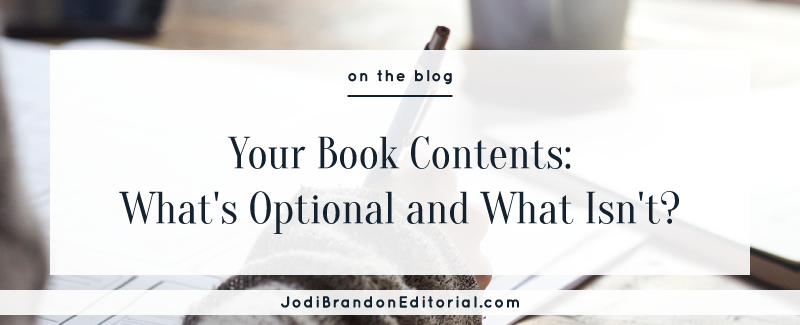Your Book Contents: What's Optional and What Isn't?
As those who’ve written books will tell you, it’s a major undertaking, and one that requires organization. It’s one thing to look at a book manuscript in Microsoft Word, but it’s entirely different when you start to actually put those files together, in order, as an actual book. You might start looking at various books in your office or home and realize that there doesn’t seem to be a cookie-cutter approach to books. They don’t all contain the same elements. So how are you supposed to know what the heck to do? What’s required versus what’s optional? I’ve got the basics covered for you with this post about the book sections/pages I get the most questions about.
Copyright Page
If books had one required element, this would be it. If you take a look at the copyright pages in a dozen books, they might all look just a bit different — BUT all will contain the three elements that make a copyright legal: the copyright notice itself (e.g., © 2017 Jodi Brandon), the reservation of rights (e.g., All rights reserved.), and the ISBN. There could be other information included, such as:
More information/details about rights reservation,
Edition information,
Printing information (e.g., Printed in the United States of America),
Author address and/or email for permissions requests,
Library of Congress cataloguing-in-publication date, if filed, and/or
Credits for cover design, formatting, and editing
Pagination
Every page in a book is counted, even if a page number isn’t printed on a page (like a chapter opener page). What trips up some self-publishing authors is this: You’ve likely also noticed that pages in the front of the book often have Roman numerals rather than Arabic numbers. Arabic numbers begin (page 1) with the text or body of the book. An easy way to remember this when you’re working on your book is to use the Table of Contents as a divider of sorts: The frontmatter that precedes it (title page, copyright page, dedication, acknowledgments) has Roman numerals and is not listed on the Contents.
Introduction vs. Preface vs. Foreword
I often hear these terms used interchangeably, but they are three distinct book sections. A foreword is similar to an intro, but written by someone other than the author. The intro introduces (see what I did there?) the book topic and tells readers what they can expect. The preface offers a little background: why the author chose to write the book or how the book came to be. Some books have all three of these. Some books have none of the three.
A foreword is similar to an intro, but written by someone other than the author. (Tweet)
Chapters and Parts/Sections
If your book is lengthy, it might make sense to split it into parts/sections. Don’t force it, though. There is no need to split a book contents this way if it doesn’t happen naturally. Let’s say your signature program, which is the topic of your book, has three stages, all of which have three steps. You might label the stages as parts and the steps as chapters.
Appendices
Some book topics lend themselves to appendices in some form or another: a glossary, perhaps, if your book is intended for a beginner-level audience; or a case study of a client who’s achieved success using the program you’re writing about; or a copy of a form that you reference in the book. Think of appendices this way: They contain information that will be helpful to your audience but isn’t essential to the main text.
Think of appendices as information that will be helpful to your audience but not essential to the main text. (Tweet)
Endnotes
Certainly you need to give proper credit when quoting another source, but there’s a way to do this that’s less formal: in-text citations. Unless you’re writing for a scholarly audience, you want your readers to have a smooth read and not have to turn to an endnotes section. You can — USUALLY — do this within the text fairly easily with working along these lines: As Famous Author wrote in Famous Book, “Here’s what she said.” Or as Famous Author writes in “Article Title” in Famous Magazine, “Here’s what she wrote.” Essentially, you want to give readers enough information to find the source if they want to read or explore further.
Want some more direction for the writing stage of the process? Check out my comprehensive self-publishing checklist, which breaks tasks into categories to make sure nothing falls through the cracks.


